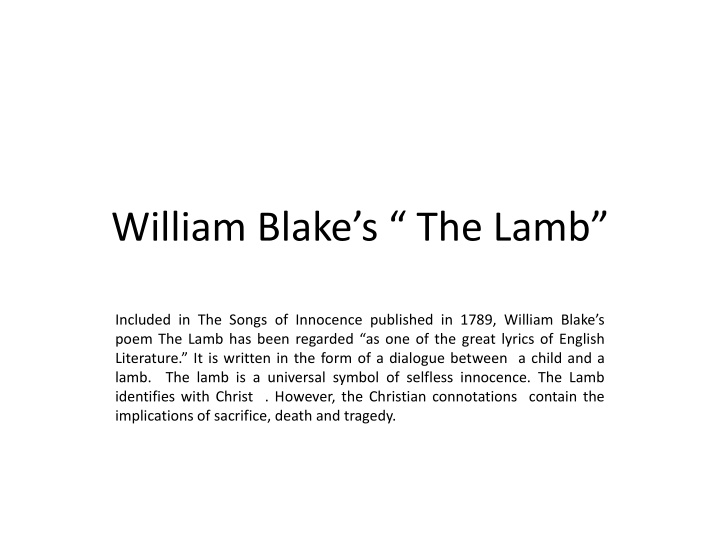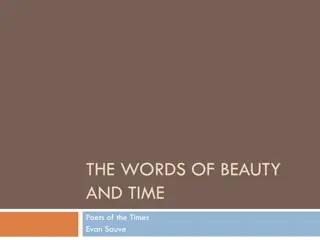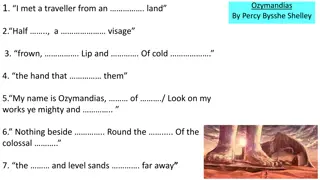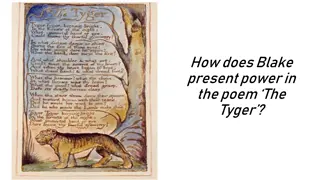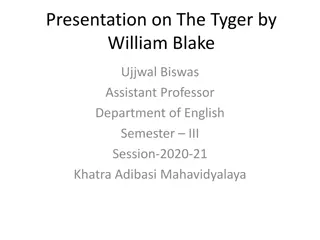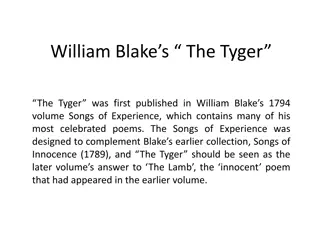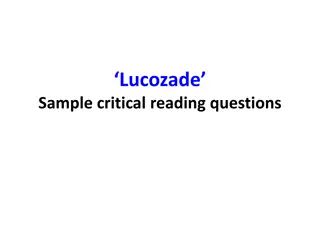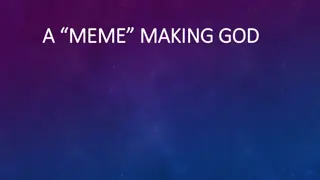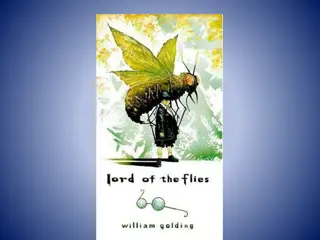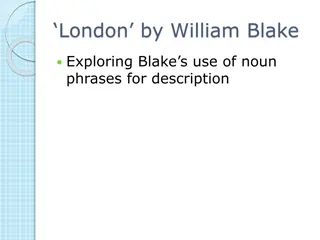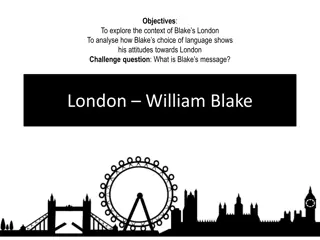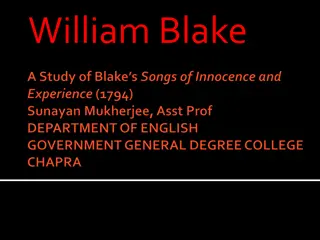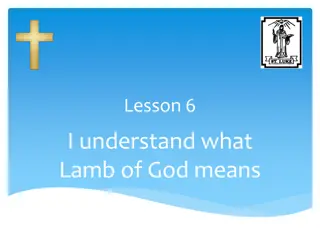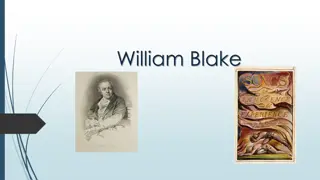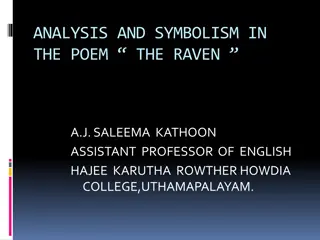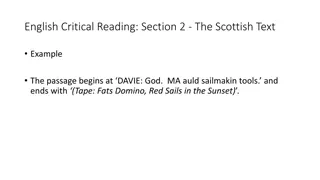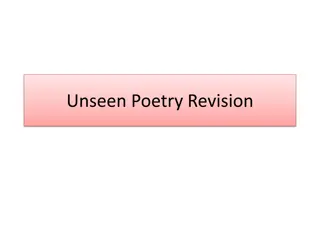Symbolism and Analysis of William Blake's Poem "The Lamb
William Blake's poem "The Lamb" from "Songs of Innocence" is a profound dialogue between a child and a lamb, symbolizing innocence and Christ-like qualities. The poem's structure, repetitive refrain, and sound devices enhance its song-like quality, while its questioning nature delves into timeless existential inquiries. The imagery of the lamb as a symbol of Jesus embodies Christian virtues such as gentleness and peace, emphasizing the deeper spiritual themes explored in this didactic piece.
Download Presentation

Please find below an Image/Link to download the presentation.
The content on the website is provided AS IS for your information and personal use only. It may not be sold, licensed, or shared on other websites without obtaining consent from the author.If you encounter any issues during the download, it is possible that the publisher has removed the file from their server.
You are allowed to download the files provided on this website for personal or commercial use, subject to the condition that they are used lawfully. All files are the property of their respective owners.
The content on the website is provided AS IS for your information and personal use only. It may not be sold, licensed, or shared on other websites without obtaining consent from the author.
E N D
Presentation Transcript
William Blakes The Lamb Included in The Songs of Innocence published in 1789, William Blake s poem The Lamb has been regarded as one of the great lyrics of English Literature. It is written in the form of a dialogue between a child and a lamb. The lamb is a universal symbol of selfless innocence. The Lamb identifies with Christ . However, the Christian connotations contain the implications of sacrifice, death and tragedy.
The Lamb is a didactic poem. In this poem, the poet pays a tribute to Lord Christ who is innocent and pure like a child and meek and mild like a lamb. The little child asks the lamb if he knows who has created it, who has blessed it with life and with the capacity to feed by the stream and over the meadow. The child asks him if the lamb knows who has given it bright and soft wool, which serves as its clothing, who has given it a tender voice which fills the valley with joy. In the firs stanza of ten lines of William Blake s poem The Lamb, the child who is supposed to be speaking to the lamb, gives a brief description of the little animal as he sees it. The lamb has been blessed with life and with the capacity to feed by the stream and over the meadow; it has been endowed with bright and soft wool which serves as its clothing; it has a tender voice which fills the valley with joy.
Form of the poem The Lamb has two stanzas, each containing five rhymed couplets. Repetition in the first and last couplet of each stanza makes these lines into a refrain, and helps to give the poem its song-like quality. The flowing l s and soft vowel sounds contribute to this effect, and also suggest the bleating of a lamb or the lisping character of a child s chant
Analysis The poem is a child s song, in the form of a question and answer. The first stanza is rural and descriptive, while the second focuses on abstract spiritual matters explanation. The child s question is both naive and profound. The question ( who made thee? ) is a simple one, and yet the child is also tapping into the deep and timeless questions that all human beings have, about their own origins and the nature of creation. and contains
Yet by answering his own question, the child, in the second stanza, converts it into a rhetorical one, thus counteracting the initial spontaneous sense of the poem. The answer is presented as a puzzle or riddle. The child s answer, however, reveals his confidence in his simple Christian faith acceptance of its teachings. and his innocent
The Symbolism of the poem The lamb of course symbolizes Jesus. The traditional image of Jesus as a lamb underscores the Christian values of gentleness, meekness, and peace. The symbolic meaning of it is almost clearly stated in the poem The Lamb which is probably the most important among the poem of innocence. Here the symbols of child, lamb and Christ are assimilated to each other. The poem begins with a child like directness and natural world that show none of the signs of grownups.
The child is a symbol of innocence, the state of the soul which has not yet been corrupted by the world of conventionalized pretensions called religion, culture, society and state and other codified systems. This overtly simple poem also subtly approaches the subject of creativity and the creator. While the speaker is speaking about a real physical lamb on the surface of it, the subtext of the poem derives from both Christian and classical mythology. The child is the symbol of Christ, the physical incarnation of the deity. The fact that it has been sent to feed among the meadow and along the stream indicates that it is to live by natural, instinctual means, or the Divine law of the nature. The wooly softness and the brightness that comes from within also support the divine nature of the lamb symbol. The voice of the lamb is also equally significant. The child, the lamb and the Christ are all close to the creative being; creativity is a child like occupation, since it also involves the natural spirit, sense of wonder and undefiled imagination.
The poet addresses lamb itself. Lamb is pure, innocent and it is associated with Christ. Being a visionary Blake invites the reader to world free form reasoning. He describes the lamb as he sees it. The lamb has been blessed with life and with capacity to drink from the stream and feed from the meadow. It has been allotted with bright, soft and warm wool which serves as its clothing. It has a tender voice which fills the valley with joy. The child, too, is an innocent child. Christ was also a child when he first appeared on this earth as the son of God. The child enjoys the company of the lamb who is analogous to the child
The poem displays the innocence the joy and affection. The lyric is a counterpart to the tiger. The Lamb and The Tyger represent the two contrary states of the human soul. The lamb represents innocence and humanity whereas the tiger represents a fierce force within man. The child asks who made the little lamb in a typical child s tone, rhythm and diction. The lamb, he says, has been given the clothing of delight , soft and wooly clothing, and such a tender voice that makes all the values rejoice. Besides, God has given the lamb the feet and told it to go and feed itself by the stream and over the meadow. But in the next stanza, the speaker himself tells the little lamb that his maker is known by the very name of the lamb. He is also gentle and mild. I a child and thou a lamb, we are called by His (Christ s) name . We have here a realistic and sympathetic portrait of a lamb. But, the symbolic meaning goes much deeper. The poem seems that it is based on the biblical hope that "meek shall inherit the world .
In the second stanza there s an identification of the lamb, Christ, and the child. Christ has another name, that is, lamb, because Christ is meek and mild like lamb. Christ was also a child when he first appeared on this earth as the son of God. The child shows his deep joy in the company of the lamb who is just like him, meek and mild. Even on its surface level the poem conveys the very spirit of childhood the purity, the innocence, the tenderness, as well as the affection that a child feels for little creatures like the lamb. There are also overtones of Christian symbolism suggested by Christ as a child. The pastoral setting is also another symbol of innocence and joy. The lamb has got not ordinary clothes but clothes of delight ; this is the first indication of the symbolic meaning in this poem. The lamb itself is a symbol: it stands for the innocent state of the soul, a dweller of the world of innocence and an emblem of purity, naturalness, and spiritual, original and natural being. The word wooly also reminds of Christ was being born with a soft wooly hair. The brightness may also be an indication of the halo or shining on the pure being.
